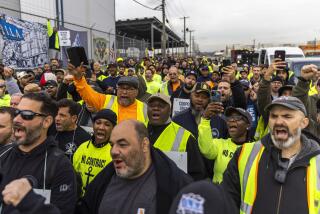Home Port : After Wars Global and Private, Dad and Son Find Haven on the Dock
- Share via
Dockworker Harry Valdivia Sr. has become part of the folklore at the Port of Hueneme. That’s just something that comes from working in one place for more than 50 years.
Valdivia was 29, an employee at a construction site at the adjacent Seabee base, when he learned there was work at the small port loading housing material onto ships for the troops overseas during World War II.
“Someone said there was longshoring work,” said Valdivia, now 79 and the oldest dockworker at the port. “I didn’t even know what a longshoreman was. I had never seen a ship.”
Much has changed since Valdivia’s first night on the dock, July 2, 1942. Back then, the Port of Hueneme was just coming into its own.
“It changed so darn much during the war,” Valdivia said. “There weren’t many people around here. Then all of a sudden the war was declared and this thing boomed. The Navy made the dock to handle eight vessels at a time. We worked around the clock, 10 hours during the day, 10 hours at night, in shifts.”
The longshoremen, whose numbers peaked at about 1,300 during the war, spent their long days at that time strictly loading naval supplies. Some of the first shipments out of the port after the start of the war included landing strips and Quonset huts. Now a variety of commercial items, from luxury cars to bananas, pass through. Not only are dockworkers handling different cargoes these days, they have an entirely new technology to help them with the heavy lifting.
Working at the docks as long as he has, Valdivia has seen several distinct phases of life there. When he started, the work was done mostly by hand. Today most of the work is done by machines in the increasingly busy commercial port.
“Harry saw when we hand-handled the cargo with crowbars, dollies, etc.,” said Tony Garcia, secretary emeritus of the International Longshoremen’s and Warehousemen’s Union Local 46.
In about 1943, Garcia said, expediency became a priority and forklifts were brought in. Then in the late 1960s, he said, the dock entered the world of electrical push-button operation.
“We used to handle everything piece by piece, whether it was drums or lumber,” Valdivia said. “It wasn’t palletized. Now it’s easy.”
After World War II, the number of longshoremen at the port declined steadily to a low of about 50 in the mid-1960s. The number increased to 300 during the Vietnam War, then dropped again to about 100, where it stands today.
In the early 1950s, Valdivia brought his son, Harry Jr., to the port to work. Valdivia said he wanted Harry Jr., then in his mid-teens, to follow in his footsteps, something that occurs often in the business.
“This industry has passed from father to son and son to grandson,” he said. “I guess the sons are so used to hearing longshoreman language at home, they figure they may as well join.”
But it didn’t come easy for Harry Jr. The younger Valdivia said his initial stint at the port was short. Since his early teens, he had been in and out of the California Youth Authority, he said, and as an adult he became a heroin user. His addiction to narcotics and alcohol landed him behind bars.
Now 57 and a father, Harry Jr. is back at the dock. Twenty-five years of prison time are behind him.
Because of cirrhosis and a decreased sense of perception, his duties are limited to unstrapping cargo cages and tying down ships. He said the work at the Port of Hueneme, however, has been regular and in recent years has kept him out of trouble.
Harry Sr. said his son’s drug problem wasn’t unique on the docks. Alcohol abuse used to be a big problem among longshoremen, he said.
“The fathers and uncles of most of the guys you see working at the port today have died of cirrhosis,” Valdivia said. Many dockworkers have gone into rehabilitation programs and the union now requires drug screenings as well as strength and endurance tests of its recruits.
Harry Valdivia Sr. remembers that July, 1942, night--his first time aboard ship.
“For three days, we were looking at that big ship,” Valdivia said. “With the fog hanging over, it was kind of haunting.” Things happened pretty fast once he and a friend got up the nerve to inquire about work. “We came here and got the job right away. We came in and worked that night.”
Though he’s seen his share of large vessels during his time at the docks, Valdivia can quickly recall that first one.
“That ship was deep, I’ll tell you, at least 50 feet down the hold, with three decks,” he said. “Me and my partner went down there. At lunchtime, everyone left the hold except my friend. He wouldn’t come out. He was afraid.”
Valdivia’s buddy ended up spending the night in the hold, subsisting on a hamburger that Valdivia fetched for him.
“We didn’t know there was an escape hatch,” Valdivia said, “and he didn’t want to use the ladder.”
With nothing more than some common sense and a survival instinct, Valdivia began the potentially hazardous dock work. He said he soon learned to count on the experienced longshoremen on duty.
Valdivia started working in the hold his first year. For a time he was a winch driver, then a foreman and a hatch boss.
“During WWII there was a lot of work,” Valdivia recalled. “We had 40 gangs working around the clock.” A gang generally had about 16 workers.
And while the Navy seemed to be drafting everyone around him, Valdivia said he was passed over because of his experience loading cargo. In fact, that experience led to him teaching Seabees how to load ships during the war.
Valdivia, who these days is a chief clerk responsible for counting cargo, shrugs off the acknowledgment he gets from co-workers for his seniority.
“I’m just a regular Joe,” Valdivia said.
That knack for job stability was something Harry Sr. couldn’t pass on to his son. Harry Jr.’s drug use and poor health were too much of a factor. His ailments have ranged from pneumonia to varicose veins in his esophagus. He takes muscle relaxants and pain pills for his cirrhosis. He has a white blood cell deficiency.
In August, 1989, Harry Jr. almost died. He had lost 80% of his blood and was admitted to the intensive care unit at St. John’s Regional Medical Center in Oxnard.
“The doctor told us it was time to call the priest,” said his wife, Charlene Valdivia, also a former drug user. Valdivia and his wife gave up their drug habits in the mid-1980s after both had been released from County Jail, they said.
“I had to take it to the limit,” Harry Jr. said.
Their lives have completely changed, he said, as have their living standards. He points to the well-kept furniture in their Port Hueneme home as proof. Being at the edge of death, said Harry Jr., changed his attitude about life. Being part of the longshoremen’s union helped too.
“You just gotta want to change,” Valdivia said. “Now I’m part of something. The union is a brotherhood. Sure there are internal conflicts once in awhile, but in the end you’re still a part of something.”
Helping Harry Jr. live life in the slow lane are his three sons, Harry III, 10; James, 7, and Jason, 4. Harry III, a star Pony League baseball player, has his eye on a career in longshoring. On a recent visit to the port, he proudly donned a union baseball cap.
Harry Jr. said he is thankful for his sometimes menial tasks at the dockyard.
“One day you have one job, the next day you have another,” he said. “It’s not always the same work. I wouldn’t trade this job for nothing.”
Harry Valdivia Sr. agreed.
“You like what you do for work and you stay with it,” he said.
The elder Valdivia said he is thinking of retiring at the end of the year, but his wife, Bernice, said he’s been saying that for at least a decade.
“All my life I’ve been a working man,” Valdivia said. “Why should I change?”
More to Read
Sign up for The Wild
We’ll help you find the best places to hike, bike and run, as well as the perfect silent spots for meditation and yoga.
You may occasionally receive promotional content from the Los Angeles Times.






